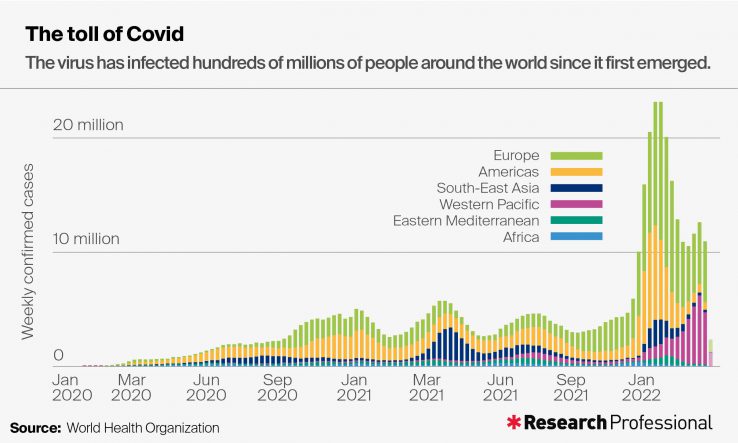
Research Professional News looks at the numbers behind the pandemic
More than two years have passed since Covid-19 first disrupted all aspects of life. In that time, scientists around the world have thrown everything they have at the virus and developed effective vaccines at
lightning-quick speed.
Funding bodies have supported them by spending billions of dollars on Covid-19 R&D, although this money has not been evenly spread across the world.
As academia and other sectors tentatively look past lockdowns and towards a future where we live with the virus, Research Professional News highlights some key numbers related to the pandemic.
Total cases
In December 2019, scientists were becoming alarmed by reports of a novel coronavirus emerging in China. But most members of the public were not worried—data from the World Health Organization (WHO) showing weekly Covid-19 cases reported two as of 30 December.
Three months later, countries across the world had imposed strict lockdowns on their residents and weekly cases had exploded to 503,278 by 30 March 2020. Since then, case numbers have continued to grow as new variants of the original virus have emerged. As of 21 March this year, weekly cases were almost 11 million.
Since the pandemic began, there have been almost 500 million cases recorded and more than six million deaths. Europe has been hit hardest, with nearly 200 million recorded cases as of 29 March.
Funding flows
According to data published by the non-governmental organisation Policy Cures Research, more than $9 billion (€8.24bn) had been committed globally to Covid-19 R&D by October 2021. Of that money, more than $2.5bn was pumped into vaccine development. Around $46 million has gone into basic research.
Funders in the United States have contributed the most cash to research—nearly $4.5bn. Those in Germany have given out $1bn, while funders in the UK have contributed more than $737m.
This spike in funding directed towards Covid-19 has had a negative impact on the fight against other diseases. A report published by Policy Cures Research in January found that overall investment in research on neglected diseases fell by 4 per cent in 2020, hitting clinical developments of treatments for diseases such as malaria.

Papers
In the last two years, researchers’ efforts to understand Covid-19 are reflected in what they have been writing about. Figures from the Web of Science Core Collection, owned by Research Professional News’s parent company Clarivate, show that as the first scientists were growing worried about the novel virus emerging in China in 2019, there were five articles with “Covid-19” in their titles.
As the coronavirus spread across the world and forced millions of people into lockdown for months at a time, the number of articles including Covid-19 in their titles reached 24,118. By the second year of the pandemic, this climbed to 55,430.
A separate report published by Clarivate provides a more detailed picture of researchers’ interest in the coronavirus. When searching Web of Science for Covid-19 in titles, abstracts and keywords, the data show that 67,756 papers—articles or reviews—were published in 2020-21 by countries in the G20 economic group.
As much of the world slowly switches from crisis mode to living with Covid-19, we can expect more challenges before the pandemic is behind us. Researchers will continue their efforts to understand this virus—and to keep one step ahead.
This article also appeared in Research Europe